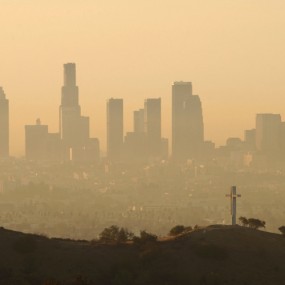
Pollution reduction measures that were aimed primarily at reducing California’s notorious smog problem and improving public health, also helped cut emissions of black carbon — a key global warming agent — according to a new study published Tuesday.
Black carbon, more commonly referred to as soot, is an atmospheric particulate that scientists have shown to be a significant contributor to global warming. It is an attractive target for emissions reductions because relatively cost effective technologies to reduce it already exist, such as diesel particulate filters for trucks, and because unlike carbon dioxide (CO2), which stays in the air for decades to millennia, black carbon only remains airborne for days to weeks.
According to the study, published in the journal Atmospheric Environment, scientists from the Scripps Institution of Oceanography and Argonne National Laboratories found that in California, statewide annual average black carbon concentrations declined by nearly 50 percent between 1989 and 2008. These reductions occurred in direct proportion to a decline in fossil fuel emissions, mainly from diesel engines, during that period. The researchers say the reductions were largely the result of laws enacted to reduce diesel pollution, instituted to benefit public health and alleviate California’s smog.
 Veerabhadran Ramanathan, a distinguished professor of atmospheric and climate sciences at the Scripps Institution of Oceanography. Credit: Scripps Institution.
Veerabhadran Ramanathan, a distinguished professor of atmospheric and climate sciences at the Scripps Institution of Oceanography. Credit: Scripps Institution.
Speaking at the annual meeting of the American Geophysical Union in San Francisco, coauthor V. Ramanathan, distinguished professor at Scripps and a prominent figure in black carbon research, said the California emissions reductions offer a demonstration of how reducing black carbon emissions can influence the climate on a regional level. “For a scientist it’s a spectacular experiment, because we can see the result of [mitigation] policies,” he said.
One of the complications facing scientists and policy makers seeking to address black carbon is that many of the processes that emit black carbon also emit other particulates, such as sulfate aerosols, that can help cool the climate. So ideally, policies aimed at reducing global warming would selectively cut the warming agents without taking away the cooling influences. Otherwise, they may cause a warming rebound.
However, hard data about what would happen if only the heat-trapping aerosols were slashed, without reducing the cooling agents, has until now been in short supply. This study, Ramanathan said, changes that. The study estimates that the decrease in black carbon led to a cooling of 1.4 watts per square meter, which it states is “sufficiently large to have had an impact on regional heat and water budget[s]” in California.
Ramanathan said this study demonstrates that black carbon emissions can be tackled state by state or country by country, rather than trying to get the entire world agree to an agreement which, as seen by the case of CO2, can be a nearly impossible task. “The whole world need not agree [to black carbon reductions],” Ramanathan said. “Local benefits nicely interface with global goods.”
The study was funded in part by the California Air Resources Board (ARB), which regulates California’s air quality in conjunction with the U.S. EPA. “This study demonstrates that ARB’s efforts to cut air pollution, whether by promoting cleaner cars or controlling agricultural burning, have significantly reduced threats to public health while also helping address climate change,” said ARB chairwoman Mary Nichols in a press release.
Ramanathan’s daughter Nithya, an assistant research professor of computer science at UCLA, has also been working to develop cellphone-based technology to monitor concentrations of black carbon. Such observations could be used to verify the effects of emissions reduction measures, among other uses, they said.
3 thoughts on “The Other Effect of CA’s Clean Air Laws”
Comments are closed.

How about supplying readers the link to the doi page for the article?
Often papers published in scientific journals are available by subscription only. This one might turn up as a PDF download on Ramanathan’s page at the Scripps site but does not appear to be there yet.
This post originated at Climate Central. You might try emailing Andrew Freedman (link in post) or posting the same question on their thread.
I was given a paper copy of the new scientific study, and had not seen an electronic version before writing the story. However, I found a DOI link from the “in press” section of the journal “Atmospheric Environment.” Here ya go:
doi:10.1016/j.atmosenv.2010.10.054
Cheers,
-Andrew